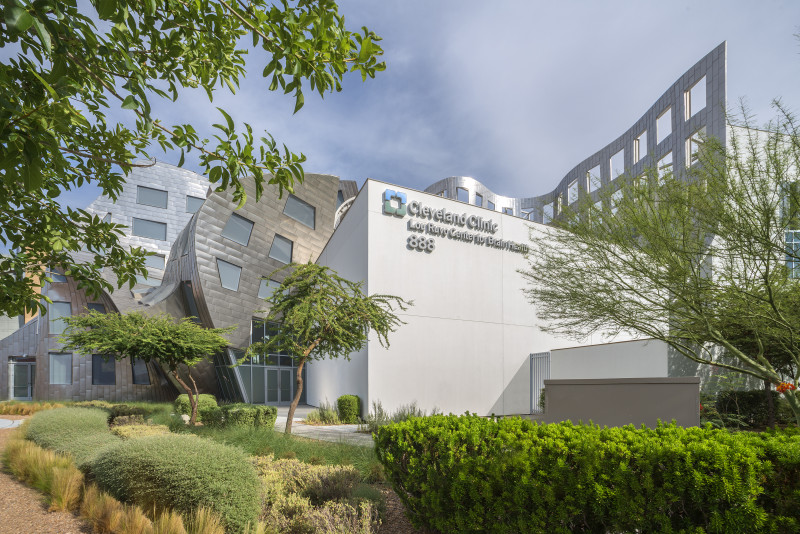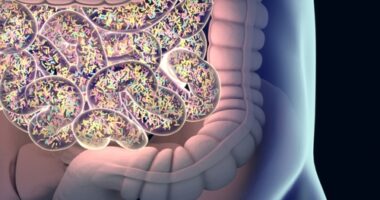New Cleveland Clinic Center Working to Prevent Alzheimer’s in Women

Photo courtesy of Cleveland Clinic
The exterior of the Lou Ruvo Center for Brain Health, which houses the new Women’s Alzheimer’s Movement Prevention Center.
A new center at the Cleveland Clinic in Las Vegas, backed by broadcast journalist Maria Shriver, is focusing its efforts on preventing Alzheimer’s disease in women, who are more at risk of developing the disorder than men.
Shriver has been a driving force in recognizing that Alzheimer’s disproportionately affects women. She became an advocate for Alzheimer’s research after her father, Sargent Shriver, a former politician and diplomat who was the founding director of the Peace Corps, was diagnosed with the disease in 20o3. He died in 2011.
She partnered with the Alzheimer’s Association in 2010 to publish the “Shriver Report: A Woman’s Nation Takes on Alzheimer’s,” which noted that roughly 67% of all Alzheimer’s patients in the U.S. are women.
Shriver’s organization, the Women’s Alzheimer’s Movement (WAM), also decided to open a clinic specializing in Alzheimer’s care for women, and in 2018 partnered with Larry Ruvo, an area businessman and philanthropist whose father, Lou, also died of the disease. The newly opened Las Vegas WAM Prevention Center at Cleveland Clinic, part of the Lou Ruvo Center for Brain Health, is recognized as the “nation’s first women-specific center for clinical Alzheimer’s disease prevention.”
A similar clinic for all at risk of Alzheimer’s, the Alzheimer’s Prevention Clinic at Weill Cornell Medicine and NewYork-Presbyterian, was opened in 2013 by Richard Isaacson, MD. The WAM center, however, specializes in coaching women, ages 30 to 60, in addressing specific risk factors for Alzheimer’s.
Shriver, appearing on a recent “Today Show” segment, highlighted research that shows that 40% of dementia cases could be prevented or delayed by 12 potentially modifiable risk factors, including changes in lifestyle habits such as diet, exercise, alcohol consumption, smoking, and low social contact. Other factors include education level, air quality, traumatic brain injury, and depression.
“For most people, it’s a really complicated dance between all these other factors,” Sandy Gleysteen, executive producer of content, program, and special projects for WAM, said in a phone interview with Alzheimer’s News Today.
And for people with a family member with Alzheimer’s, the risk for developing the disease can go up anywhere between 20% and 25%, according to Jessica Caldwell, PhD, director of the WAM Prevention Center.
‘Genes are not your destiny’
Researchers have identified links between certain genes, particularly the APOE4 gene, and the risk of developing Alzheimer’s, but not all with these genes will develop the disease. Genes that are deterministic, or those that directly cause Alzheimer’s and guarantee a person will develop the disease, are rare and account for only 1% or fewer cases.
“What we’ve learned is that genes are not your destiny,” Gleysteen said.
An inaugural center patient is Marjorie Gray, 36, whose father Bill was diagnosed with Alzheimer’s five years ago when he was 64. Gray was concerned about her potential for getting the disease: an aunt and both paternal grandparents and their siblings also had Alzheimer’s.
“I suddenly was faced with my own mortality of what could happen,” Gray said.

Marjorie Gray with her father, Bill Gray. (Photo courtesy of Marjorie Gray)
However, that feeling has changed after her initial April appointments at the center, two in-person, and one virtually. Gray, a manager at Google, added cognitive exercises, such as The New York Times Sunday crossword puzzle and relearning Spanish, and diet changes, including cutting out meat and dairy, to help lower her risk of developing Alzheimer’s.
“I finally felt like at least I’m trying,” Gray said. “At least I’m doing something.”
Shriver had the idea for the clinic for at least three years before it became a reality, Gleysteen said. She discussed the need for such a center with Larry Ruvo, who partnered with the Cleveland Clinic to open the Lou Ruvo Center for Brain Health, designed by the architect Frank Gehry, in 2010. Lou Ruvo died of Alzheimer’s complications in 1994.
The first 150 available spots were open to a select group of women with certain risk factors, such as age, genetic makeup, and family history. Still, the clinic filled that number almost instantaneously. After Shriver’s “Today Show” segment on the center aired, the phone lines at Cleveland Clinic Nevada crashed under the demand.
“It’s really a bigger play here. How empowering, how amazing, how gratifying to think that we could be avoiding this disease and preventing it rather than having to deal with the consequences,” Gleysteen said.
So far, the clinic has had 119 patients complete initial visits and plans on seeing another 250 more people over the course of its three-year pilot run. Individuals can fill out an online survey to put their name on the list when appointments become available again in January 2022.
Women in Alzheimer’s research
WAM has a history steeped in Shriver’s work as California’s first lady. She started the Women’s Conference, a 14,000-person network of women, during her former husband Arnold Schwarzenegger’s eight-year term as governor from 2003 to 2011. According to Gleysteen, Shriver observed that the best-attended breakout session of the conference was on caregiving. Her journalistic curiosity led her to learn more about Alzheimer’s and help pen the cutting-edge report.
That report, along with her work raising money for the Alzheimer’s Association, her multimedia storytelling of the impact Alzheimer’s has on women, and her awareness campaigns of how this disease affects women, led her to start A Woman’s Nation, out of which grew the nonprofit foundation, WAM. In 2020, the organization raised about $1.5 million from events and donations.
In addition to the WAM Prevention Center, the foundation is focused on funding research that could help thwart the development of Alzheimer’s by understanding the relationship between seemingly disparate biological systems. The foundation has put $3.5 million toward seed grants.
Researcher Laura Cox, PhD, an instructor in neurology at the Ann Romney Center for Neurologic Diseases at Harvard Medical School, Brigham and Women’s Hospital, is working on a hypothesis that gut health and brain health are intertwined, funded in part by WAM.
Another scientist with WAM funding is Roberta Diaz Brinton, PhD, director of the University of Arizona Center for Innovation in Brain Science. Brinton is looking at the potential correlation between type 2 diabetes treatments and Alzheimer’s risk.
Lisa Mosconi, PhD, who wrote the book, “The XX Brain: The Groundbreaking Science Empowering Women to Maximize Cognitive Health and Prevent Alzheimer’s Disease,” and who serves as director of the Weill Cornell Women’s Brain Initiative, is using PET scans to understand how estrogen affects the brain. She’s also investigating how pregnancy and other reproductive factors, for example, could factor into a person’s risk for the disease.
Most of the studies funded by WAM are led by women. That’s by design.
“We are very focused on wanting to make sure that our researchers and the people that we’re funding look like the rest of our country does,” Gleysteen said. “That means there are women researchers, as well as women of color.”
In that vein, WAM also is funding a study led by Kendra Ray, PhD, director of the dementia program for the nonprofit health system MJHS. Ray is investigating ways to reduce caregiver stress, including a study that assesses the benefits of online worship for African American families.
“We have to put the money into research; we have to fund women’s health and brain health,” Gleysteen said. “They’re prerequisites to understanding the disease that will help us learn how to prevent the disease.”







